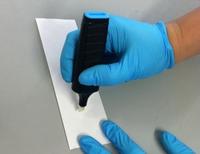-
FBI: Lawmakers should mandate surveillance “backdoors” in apps, operating systems
FBI director James Comey said that the agency was pushing lawmakers to mandate surveillance functions in apps, operating systems, and networks, arguing that privacy and encryption prevent or disrupt some of the agency’s investigations. According to Comey, new privacy features implemented by Google and Apple in the wake of the Snowden revelations, automatically encrypt user communication and data, making it difficult for law enforcement to gather evidence and connect links among suspected criminals and terrorists.
-
-
Boeing completes testing of new anti-jamming technology

Boeing says it has proven its new anti-jamming communications technology is capable of operating as either a ground-based user terminal or satellite-based networking hub, enabling the military to send and receive secure communications at a significantly lower cost by using existing terminals and satellites.
-
-
Mental-health apps may reduce number of mass shooting events
Between 1982 and 2011, mass shootings occurred every 200 days on average. S since 2011, mass shootings have occurred every sixty-four days on average. Mass shootings have one thing in common: the culprits all suffered from mental illness and the condition was known to at least one person. New mobile app educates the public about mental illness and provides local and national resources for early intervention and treatment.
-
-
ICE offices subscribed to national license-plate database in violation of DHS policy
In February, DHS officials dropped a controversial bidwhich would have allowed the department to access a national license-plate database, citing possible violation of Americans’ civil liberties. Soon after, DHS officials established a policy which required similar plans to be reviewed by department privacy officers. Roughly two months after that policy was put in place, officials with DHS’s Newark and Houston field offices of the Immigration and Customs Enforcement(ICE) agency purchased subscriptions for a commercially run national license-plate database without approval from DHS’ privacy office.
-
-
Peekaboo, I see you: Government authority intended for terrorism is used for other purposes
The Patriot Act continues to wreak its havoc on civil liberties. Section 213 was included in the Patriot Act over the protests of privacy advocates and granted law enforcement the power to conduct a search while delaying notice to the suspect of the search. Known as a “sneak and peek” warrant, law enforcement was adamant Section 213 was needed to protect against terrorism. But the latest government report detailing the numbers of “sneak and peek” warrants reveals that out of a total of over 11,000 sneak and peek requests, only fifty-one were used for terrorism. Yet again, terrorism concerns appear to be trampling our civil liberties.
-
-
Next-generation technology for first responders: intuitive, instinctive, and interoperable
DHS’s Science and Technology Directorate (S&T) has a vision for a new age of first responders, a vision which will enable first responders and their technology to be more intuitive, instinctive, and interoperable.TheNext-Generation First Responder suit will incorporates wearables, the Internet, and cellular connectivity, along with multiple environmental and biological sensors to help firefighters, law enforcement, and aid workers, better perform their jobs safely.
-
-
Law enforcement: Apple iOS 8 software would hinder efforts to keep public safety

With its new iOS 8 operating software, Apple is making it more difficult for law enforcement to engage in surveillance of users of iOS8 smartphones. Apple has announced that photos, e-mail, contacts, and other personal information will now be encrypted, using the user’s very own passwords — meaning that Apple will no longer be able to respond to government warrants for the extraction of data.
-
-
Canada considering expanding powers of its security agencies
The Harper government is considering legislation which would expand the powers of the Canadian Security Intelligence Service (CSIS) to investigate, apprehend, and detain homegrown terrorists. CSIS wants the power to take advantage of the so-called “Five Eyes” spy network to which Canada, the United Kingdom, America, Australia, and New Zealand all belong. CSIS is also asking for more power to track Canadians believed to have been radicalized, and to take more advantage of anonymous sources. Ottawa officials are talking about whether to give CSIS explicit legislative permission to engage in “threat-diminishment” — a power which the intelligence agency’s watchdog recently pointed out that CSIS already uses, but the law does not explicitly permit.
-
-
Bullet-tracing technology helps nab criminals
Firing a gun leaves a unique carving on each bullet, what some police officers refer to as the gun’s DNA. The Minneapolis Police Department(MPD) has upgraded its bullet-tracing technology, or integrated ballistic identification solution (IBIS), quickly to match bullets to different crimes around the city, and soon around the country. The National Integrated Ballistic Information Network(NIBIN) is a national database of bullets and shell castings that shares information on the markings left on a bullet after it passes through a gun’s chamber.
-
-
FBI wants Congress to mandate backdoors in tech devices to facilitate surveillance
In response to announcements by Appleand Googlethat they would make the data customers store on their smartphones and computers more secure and safer from hacking by law enforcement, spies, and identity thieves, FBI director James Comey is asking Congress to order tech companies to build their devices with “backdoors,” making them more accessible to law enforcement agencies.Privacy advocates predict that few in Congress will support Comey’s quest for greater surveillance powers.
-
-
Growing scrutiny of police use of Stingray surveillance technology
IMSI-catcher (International Mobile Subscriber Identity), aka Stingray, is a surveillance technology which simulates cell phone towers in order to intercept mobile phone calls and text messages. Privacy advocates have scrutinized the use of Stingrays in U.S. cities because, when the device tracks a suspect’s cell phone, it also gathers information about the phones of bystanders within the target range. Additionally, police use Stingrays without properly identifying the technology when requesting search warrants has raised concerns.
-
-
Building a better lie detector
The Intelligence Advanced Research Projects Activity (IARPA), within the Office of the Director of National Intelligence (ODNI), announced the other day the winner of its first public challenge contest, Investigating Novel Statistical Techniques to Identify Neurophysiological Correlates of Trustworthiness (INSTINCT). The winning solution, JEDI MIND — Joint Estimation of Deception Intent via Multisource Integration of Neuropsychological Discriminators — uses a combination of innovative statistical techniques to improve predictions approximately 15 percent over the baseline analysis.
-
-
A crime-fighting “magic” marker pen picks up hidden fingerprints

A crime-fighting “magic” marker pen that can identify the hidden properties of receipts containing fingerprint deposits within a matter of seconds will be demonstrated at the Knowledge Transfer Network’s (KTN) Applications of Forensic Science Research and Development Technology Showcase 2014 event today (8 October) in London.
-
-
Nanoparticles will allow detecting previously undetectable fingermarks
A group of researchers from Switzerland has thrown light on the precise mechanisms responsible for the impressive ability of nanoparticles to detect fingermarks left at crime scenes. The researchers have provided evidence contesting the commonly accepted theory that nanoparticles are attracted to fingermarks electrostatically. The attraction, they claim, is in fact chemical and is caused by compounds on the surface of nanoparticles bonding with a complex cocktail of compounds present in fingermark residue.
-
-
Investigative genetics technology helps nab criminals
Every year, investigators collect tens of thousands of biological samples from crime scenes that may hold valuable clues to solving criminal cases. Unlocking those clues now is easier thanks to a new software solution unveiled last week by Battelle researchers who have applied advanced bioinformatics to next-generation sequencing data. ExactID analyzes biomarkers that can predict physical appearance, ancestry, clinical traits, and familial relationships among people. This information can be invaluable to forensic analyses and case work.
-
- All
- Regional
- Water
- Biometrics
- Borders/Immig
- Business
- Cybersecurity
- Detection
- Disasters
- Government
- Infrastructure
- International
- Public health
- Public Safety
- Communication interoperabillity
- Emergency services
- Emergency medical services
- Fire
- First response
- IEDs
- Law Enforcement
- Law Enforcement Technology
- Military technology
- Nonlethal weapons
- Nuclear weapons
- Personal protection equipment
- Police
- Notification /alert systems
- Situational awareness
- Weapons systems
- Sci-Tech
- Sector Reports
- Surveillance
- Transportation
Advertising & Marketing: advertise@newswirepubs.com
Editorial: editor@newswirepubs.com
General: info@newswirepubs.com
2010-2011 © News Wire Publications, LLC News Wire Publications, LLC
220 Old Country Road | Suite 200 | Mineola | New York | 11501
Permissions and Policies
Editorial: editor@newswirepubs.com
General: info@newswirepubs.com
2010-2011 © News Wire Publications, LLC News Wire Publications, LLC
220 Old Country Road | Suite 200 | Mineola | New York | 11501
Permissions and Policies
